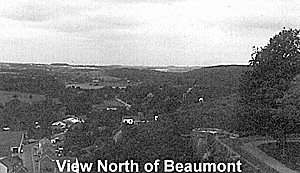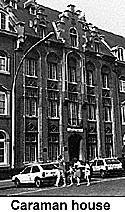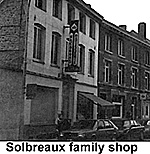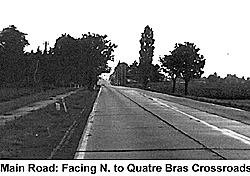 Beaumont looks like any other small Belgian town. But Napoleon passed through it in 1815, just days before his final defeat at Waterloo, and ensured Beaumont a place in history.
Beaumont looks like any other small Belgian town. But Napoleon passed through it in 1815, just days before his final defeat at Waterloo, and ensured Beaumont a place in history.
Napoleon left Paris in the early hours of Monday, 12 June 1815. He headed north-east, to join his Army of the North which he had assembled secretly south of the Belgian border. This was one of the most extraordinary armies of his career, the one that he would lead to defeat and into legend at Waterloo.
Napoleon passed the night of 12/13 June at Laon and then pressed on to Avesnes. After a night at Avesnes, he came on 14 June to Beaumont and established his headquarters there. Beaumont was his last stop on French soil before he invaded the United Netherlands.
Today, the Franco-Belgian border lies west and south of Beaumont, which is part of Belgium. [1] But in 1815 the frontier was to the north and Beaumont was French. The frontier alteration was the work of the Congress of Vienna immediately after the 1815 campaign and was designed to lessen the chances of the French launching another surprise invasion across the River Sambre in the future. For the addition of territory to Belgium meant that a French army would have further to march before it reached the crossing point over the Sambre at Charleroi.
Beaumont has no railway station. Buses are the only way to reach it by public transport.
[2] The buses to Beaumont leave from the important industrial town of Charleroi, which lies due south of both Brussels and Waterloo. Charleroi is an important point on the Belgian railway network and is easy to reach from Brussels.
You will find the relevant buses immediately outside Charleroi-Sud railway station.
It is fifteen miles from Charleroi south-westwards to Beaumont. The bus first passes through the suburbs of Charleroi and then ascends from the valley of the River Sambre. After that, it runs along the long, straight N6. You arrive at Beaumont, which lies on a height that overlooks the surrounding countryside.
More Locations
Now follow the signposts to the Tour Salamandre, an isolated remnant of Beaumont's ancient fortifications and today a museum. The third floor is devoted to the Napoleonic era. Copies of contemporary letters offer insights into the period after Napoleon's defeat at Waterloo when French troops streamed back through Beaumont in flight. For instance, a letter of 30 June from a royalist official of Avesnes requests information on the property of local people who had openly supported Napoleon, had favoured his return from Elba or who had now just followed his retreat to Paris. Another letter, dated 1 July, concerns the establishment of a military hospital at Beaumont. Other items on display include authorisations to collect rations, reminders of the shortages imposed by thousands of hungry soldiers who suddenly descended on the region.
In the corner of the room you see a life-size model of a bloodstained French fugitive from Waterloo. One of the wounded soldiers to pass through Beaumont was Lieutenant-General Count Maximilien Foy who had been struck by a musketball in the shoulder. His ADC, Major Lemonnier-Delafosse, took him into a house to beg for soup. 'Alas, sirs,' the lady inside told them, 'This is the tenth general to enter my house since dawn. I have nothing left!' Nevertheless, she was able to give them some linen with which to bandage Foy's wound.
Outside, the streets were blocked by caissons which had been unhitched from their horse teams, abandoned and then broken into by looters. Baggage, papers and flour covered the cobblestones. Such was the catastrophic wreck of Napoleon's army. A column of French cavalry approaching the town from the north saw a small unit of green-coated hussars emerge from a wood and mistook them for foes. The column dissolved into a mob and charged into the packed streets shouting 'the Prussians! The Prussians!'
Major Lemonnier-Delafosse was disgusted. 'Looters and fugitives – such were the men I encountered.' Sword in hand, he tried to stop one rascal only to be bayoneted in the left arm for his pains. His own self-discipline had made him forget that, 'in such circumstances, the soldier is no more than a savage animal. Wounded by a Frenchman! After having run all the risks of two battles on 16 and 18 June without injury!'
One of Lemonnier-Delafosse's friends unwisely dismounted and led his horse by the bridle to a house for a glass of water. When he turned to leave, he found himself holding merely a cut portion of bridle, as a fugitive had stolen the horse. Lemonnier-Delafosse himself was caught up in the flood of fugitives which swept him out of Beaumont to the south without being able to rejoin General Foy. [5] Such was the typical experience of a defeated French soldier passing through Beaumont.
You pass first along relatively high ground, until the descent into the Sambre valley at Charleroi. North of Charleroi, the road climbs gently but steadily through Jumet towards Gosselies. Soon you come to the battlefield of Quatre Bras, where the road slopes upwards to the crossroads; Lieutenant-General François Kellermann led an awesome cuirassier charge along this stretch. Pass the traffic lights at the crossroads and then sweep on northwards. You are now following Wellington's retreat of 17 June through the narrow, twisting streets of Genappe to the battlefield of Waterloo.
The whitewashed walls of La Haie Sainte flash by and you cross Wellington's ridge. It is not a particularly prominent ridge but note that it is the best one south of Brussels. The once small village of Waterloo is now a built-up town; houses extend all along the road to join what was once the village of Mont St Jean. Further north, you pass surviving sections of the Forest of Soignes, through which Wellington could have pulled back his army if defeated.
Soon you enter Brussels itself, where Wellington learnt on 15 June of the French troops attacking those little towns and villages far away to the south near the French border, places that you have left only a few hours before.
[1] At one point, the frontier is barely over a mile west of from Beaumont.
A comprehensive guidebook to the battlefield of Waterloo, and its associated sites, is the newly-published On the Fields of Glory: The Battlefields of the 1815 campaign (Greenhill Books, 1996), by Andrew Uffindell and Michael Corum. The authors use vivid eyewitness accounts and numerous maps and diagrams to describe the fighting in the various sectors of the battlefield.
 Find the church in the town centre and almost directly across the Grand'Place you will see the house of Monsieur Caraman. This is where Napoleon took up quarters on the evening of 14 June; a bronze plaque bearing a Napoleonic eagle symbol and affixed to the wall records the Emperor's stay. The inauguration of this plaque took place in 1992 with a parade by re-enactors uniformed as lancers, cuirassiers and Imperial Guardsmen. The facade facing the Grand' Place was transformed shortly after Napoleon's stay into a neo-Gothic style. However, the south side remains the same. The house is private property [3] but you can see the south facade through the rear windows of the adjoining Town Hall. The little tourist information office east of the Town Hall sells old postcards of Napoleon's room.
Find the church in the town centre and almost directly across the Grand'Place you will see the house of Monsieur Caraman. This is where Napoleon took up quarters on the evening of 14 June; a bronze plaque bearing a Napoleonic eagle symbol and affixed to the wall records the Emperor's stay. The inauguration of this plaque took place in 1992 with a parade by re-enactors uniformed as lancers, cuirassiers and Imperial Guardsmen. The facade facing the Grand' Place was transformed shortly after Napoleon's stay into a neo-Gothic style. However, the south side remains the same. The house is private property [3] but you can see the south facade through the rear windows of the adjoining Town Hall. The little tourist information office east of the Town Hall sells old postcards of Napoleon's room.
 Two other places in Beaumont deserve a visit. North-east of the Grand Place is the shop of the Solbreux family, in the rue de Binche. Here, the family has sold Beaumont's famous hand-made macaroons for years. According to tradition, the recipe came from one of Napoleon's cooks when he passed by in 1815. Alas for legend, the local historian Arthur Robert has discovered written evidence showing that the macaroons were made in Beaumont in 1814 if not before. Another version of the tradition has it that one of King Louis XIV's retinue was the origin of the recipe. [4]
Two other places in Beaumont deserve a visit. North-east of the Grand Place is the shop of the Solbreux family, in the rue de Binche. Here, the family has sold Beaumont's famous hand-made macaroons for years. According to tradition, the recipe came from one of Napoleon's cooks when he passed by in 1815. Alas for legend, the local historian Arthur Robert has discovered written evidence showing that the macaroons were made in Beaumont in 1814 if not before. Another version of the tradition has it that one of King Louis XIV's retinue was the origin of the recipe. [4]
 You will find many other relics of 1815 between Beaumont and Charleroi. Michel Conreur's superb booklet, De Thuin à Waterloo (1990), covers them in detail. It is fascinating to travel along the main road from Beaumont to Charleroi and then northwards via Quatre Bras and Waterloo to Brussels; this can be done by bus.
You will find many other relics of 1815 between Beaumont and Charleroi. Michel Conreur's superb booklet, De Thuin à Waterloo (1990), covers them in detail. It is fascinating to travel along the main road from Beaumont to Charleroi and then northwards via Quatre Bras and Waterloo to Brussels; this can be done by bus.
Notes
[2] I found no bus link between Beaumont and France when I visited the town in 1993 and 1994. Thus you will need your own transport to cross the French border and reach Avesnes, Napoleon's headquarters on the night of 13/14 June, from Beaumont.
[3] It has been occupied since 1938 by a religious institution.
[4] A. Robert, Tour Salamandre au pays de Beaumont (1991), p.22
[5] M. Lemonnier-Delafosse, Souvenirs militaires (1850), pp.403-5
Back to Table of Contents -- First Empire #36
Back to First Empire List of Issues
Back to MagWeb Master Magazine List
© Copyright 1997 by First Empire.
This article appears in MagWeb (Magazine Web) on the Internet World Wide Web. Other military history articles and gaming articles are available at http://www.magweb.com